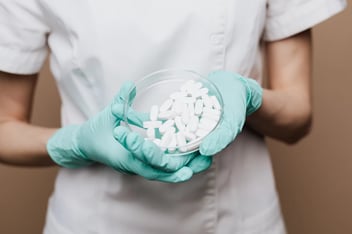Introduction:
The term “moulage” comes from the French word for “mold” or “casting.” Moulage is the art of applying mock injuries and other realistic medical conditions to actors or manikins in a simulation-based training environment. Using moulage reflects the technique’s origins in using molds and prosthetics to simulate injuries and conditions.
This technique is used in the medical field to create an immersive and realistic learning experience for students. It is most commonly used for emergency response training but can be used across many fields and learning scenarios.
Moulage is a versatile tool in Nursing Education, offering endless possibilities. From bruises and surgical wounds to obesity and pitting edema to stomas, vomit, and foley bag contents, moulage creates a realistic, hands-on experience for students, enhancing their learning in various scenarios.
How does moulage relate to nursing simulations? There are three main reasons it should be used:
- To support the learning objectives for the simulation-based activity
- To increase the realism, leading to better student buy-in.
- To enable students to hone assessment skills and practice describing their findings.
Benefits of Moulage
While there are many reasons to use moulage in nursing education, many may wonder if it benefits nursing students' education. In addition to the reasons mentioned above, using moulage is beneficial in helping students adapt to the sights, sounds, and smells associated with genuine patient care. For example, if students have experienced a necrotic wound in simulation with how it looks and smells, it will be easier to control their reaction to such a wound in the clinical setting. The ability to “not flinch” in front of a patient can help establish rapport with the patient, who is likely self-conscious, embarrassed, or isolated due to their condition.
In addition to this, it is effective in improving nurses' clinical skills. Nursing students have to master many skills besides patient care. For example, documentation is a very important nursing skill. With the addition of reasonable and accurate moulage to their sims, students can practice and refine documentation skills following their assessment skills.
Let’s take an example from a project I did at a hospital system related to pressure injuries. We used custom-made moulage task trainers that the nurses could pick up, handle, manipulate, describe, and measure without harming a real patient. The Wound Care Nurses, my subject matter experts in staging wounds, provided the “answer key” to the best practices in documenting each wound we created. When the learners came to the sim lab, we had an explanation video starring the Wound Care Nurse that could be referred to after the nurses did their assessments to compare with the expert. We aimed to ensure pressure injuries were staged and documented accurately so that the correct treatment could be initiated and insurance coverage was accurate for the patient's expenses.
Moulage provides fidelity for the injuries and conditions they will most likely see in real-life scenarios. Here are some pictures that show how it can be used in high-fidelity scenarios with student nurses:
- Cigarette burns:
- Cutting
\
- Bruises
- Rash
- Bodily Fluids
- Dog Bites
- Frost Bite
- Burns
How Can Sim2Grow Help?
Moulage is something that is incorporated into our learning system. The Sim2Grow system comes with three patients already loaded into the software for an easy start to begin using the system immediately. These patient cases can be used in the skills acquisition or simulation lab. Each of them can be enhanced in the following way with the addition of very simple moulage:
- The patient with heart failure experiencing shortness of breath can have either a Foley catheter with dark amber urine (250 mL) or place a urinal on the side rail with the urine in it.
- The patient admitted for a necrotic diabetic foot ulcer can have not only a simulated wound applied to his right heel, but the dressing on the wound could have “drainage” on it to enhance the realism further when the wound is assessed.
- The third patient is a post-op patient who can have a surgical incision. If immediately post-op, the dressing can have a Jackson Pratt drain secured underneath it. If desired, a small amount of serosanguinous drainage can be put in.
When should instructors use or not use moulage to enhance learning? Educators can tailor their use of moulage based on the desired learning objectives. If the objective is related to med pass skills acquisition with lower-level students, then the presence of moulage is unnecessary. In a high-fidelity simulation scenario, adding moulage will help students assemble all their skills in a realistic environment.
Conclusion
Moulage is the best way for students to get realistic hands-on experience to prepare them for their careers. Applying appliances or alterations to manikins, task trainers, or standardized patients can be simple or complex. It can be leveraged in various ways, including reusable pieces or makeup that can be removed and reapplied.
Using moulage not only helps students with their patient care techniques but can also help them with their documentation and assessment skills. The experience gained in how wounds or conditions can look and smell can help create a more comfortable environment for the patient if the nurse has prior experience and knows what to expect.
Moulage is worth incorporating into your nursing program because of its immersive abilities. To get started on the path to being a confident moulage artist, try these resources:



